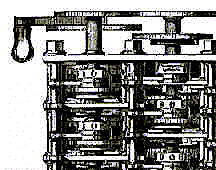

Most of his life Charles Babbage's ambition was to
build his own calculating machine. After large sums
of money from the government, the project was never
completed. One of the reasons was that it was too
clumsy. His idea was soon developed by Alan Turin
though, and today he is known as 'the grandfather of
the modern computer'.


Some of Charles Babbage's friends and acquaintances
also became famous inventors, writers or theologists,
they include:
Christian Bunsen (inventor of the Bunsen burner)
Isambard Kingdom Brunel (writer)
Charles Darwin (produced the theory of evolution)
Charles Dickens (writer)
Michael Faraday (inventor of the electric motor and
electric generator)
John Herschel (Helped with Babbage's inventions and
invented something himself)

This is a copy of Babbage's original design for the
Analytical Engine which was a more sophisticated
version of the Difference Engine. The Difference
Engine was invented in 1822 and was the first
invention that could possibly be considered to be a
computer in modern definition. When the Difference
Engine was part way through being constructed, Babbage
came up with the idea of the more sophisticated
Analytical Engine.

150 years after Babbage came up with the idea of the
Difference Engine, it was completely constructed for
the first time. A team at the London Science Museum
used Babbage's original drawings to build the 6 ½ foot
tall and 10 foot wide machine weighing three tons made
of steel, cast iron and bronze.
In the early 1990's, the Difference Engine was used
for the first time to perform calculations. The
accuracy was shown to be far better than most modern
pocket calculators. The calculations had an amazing
31 digits of accuracy! The Difference Engine is more
difficult to use than modern calculators because for
each calculation, the crank has to be turned many
times, whereas modern calculators require only the
pressing of a few buttons to perform the same
calculations.